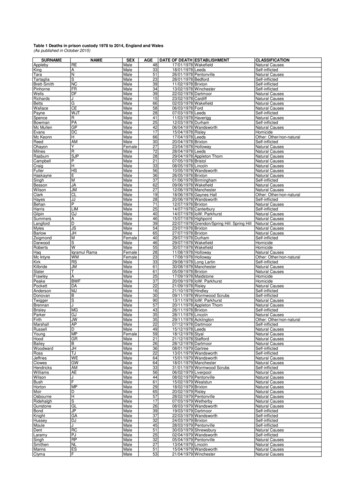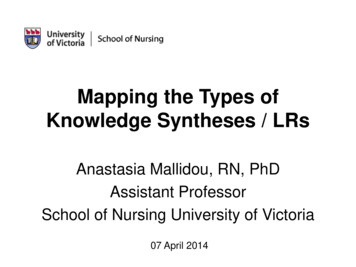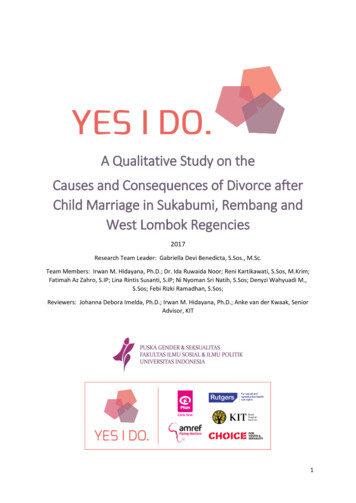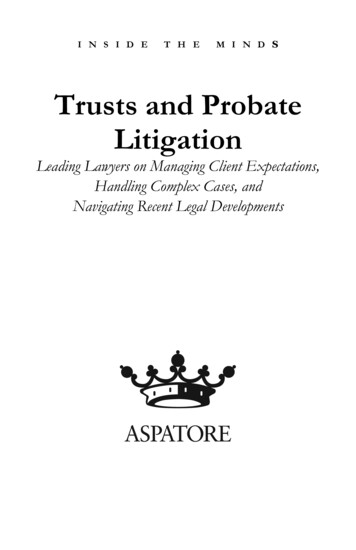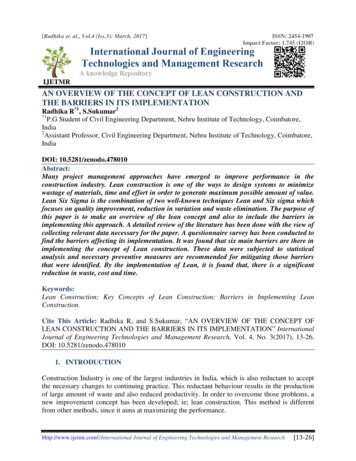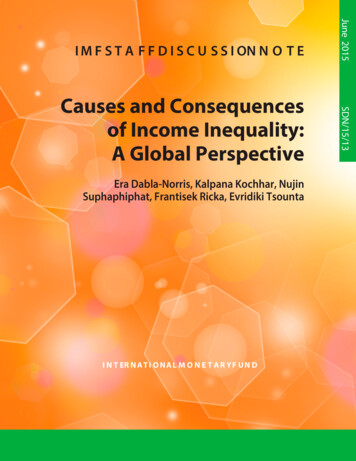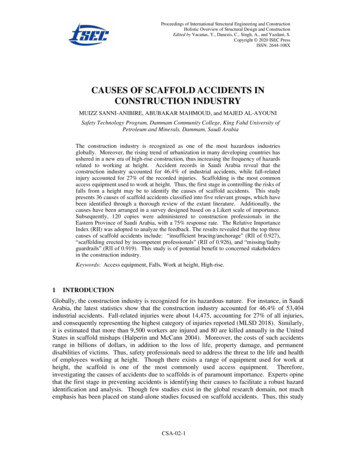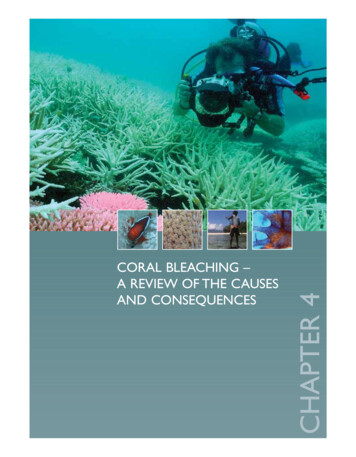
Transcription
CHAPTER 4CORAL BLEACHING –A REVIEW OF THE CAUSESAND CONSEQUENCES
A REEF MANAGER’S GUIDE TO CORAL BLEACHING4. CORAL BLEACHING – A REVIEW OF THECAUSES AND CONSEQUENCESThe mass coral bleaching events that have occurred throughout the tropics over the lastdecade have provided unprecedented opportunity, and motivation, to study thisphenomenon. As a result, knowledge about the causes and consequences of coral bleachinghas increased substantially in recent years. This accumulating body of information isproviding critical advances in our understanding and has generated new insights, which canassist reef managers to respond to the threat of coral bleaching. This section aims toprovide a summary of recent developments in the science of coral bleaching, highlightingemerging knowledge and recent insights that are most relevant to reef managers. Kirsten Michalek-Wagner4.1 What is coral bleaching?The zooxanthellae can be clearlyseen as golden-coloured dots inthis close-up image of a coralpolyp.The symbiotic relationshipwith these tiny dinoflagellatesenables corals to gain energyfrom sunlight4.1.1 The coral-algal symbiosisThe great majority of corals live in a symbiotic relationshipwith zooxanthellae, a type of single-celled dinoflagellatealgae. These microscopic algae live within the coral's tissues.Zooxanthellae produce energy-rich compounds throughphotosynthesis, providing a food source that is absorbed andused by the coral. In general, corals are highly dependent onthis symbiotic relationship, receiving up to 90 per cent oftheir energy requirements in this way17.Bleaching is a stress response that results when the coralalgae relationship breaks down. The term 'bleaching'describes the loss of colour that results when zooxanthellaeare expelled from the coral hosts or when pigments withinthe algae are degraded. Because the photosynthetic pigments found in zooxanthellae givecorals most of their colouration, the loss of zooxanthellae renders the tissue largelytransparent.The white of the calcium carbonate skeleton is then clearly visible through theun-pigmented tissue, making the coral appear bright white or 'bleached'24. Bleaching alsooccurs in other animals that are engaged in symbiotic relationships with zooxanthellae, suchas foraminifera, sponges, anemones and giant clams.Bleaching is a stress response thatresults when the coral-algaerelationship breaks down98In some instances, coral bleaching will result in coralstaking on a pastel shade of blue, yellow or pink ratherthan turning bright white. This is due to proteinsproduced by some corals, which tint the coral tissue andbecome the dominant pigment during bleaching, whenzooxanthellae are absent110, 111.
CORAL BLEACHING – A REVIEW OF THE CAUSES AND CONSEQUENCESabIt isn't only corals that bleach; other organisms that have zooxanthallae, such as this (a) giant clam and (b)anemone can also bleach in response to thermal stressThe role of temperature and light. Increased temperatures cause bleaching by reducing theability of the photosynthetic system in the zooxanthellae to process light. Whentemperatures exceed certain thresholds, incoming light overwhelms the photosyntheticapparatus, resulting in the production of reactive oxygen species that damage cellularstructures24, 112. Corals cannot tolerate high levels of these toxic molecules, and they mustexpel the zooxanthellae to avoid tissue damage. Because of the low tolerance of thephotosynthetic process to high temperatures, even normal levels of sunlight are enough todamage the photosynthetic system of the zooxanthellae when temperatures exceedcertain levels23, 113. Furthermore, as light levels increase the amount of damage due tothermal stress increases as well24.The relationship between temperature and light inBleaching is reduced in shaded reefcausing coral bleaching helps explain observations ofareas because light levels influencereduced bleaching on shaded parts of coral colonies orthe amount of damage caused bytemperature stressin shaded reef areas9, 114, 115. It also suggests that the spatialextent and patterns of bleaching responses may beinfluenced by factors that determine the amount of solar radiation to which corals areexposed. These factors might include cloud cover46, attenuation in the water column116,stratospheric ozone18 and shading by large landforms such as steep-sided shorelines39.99CORAL BLEACHING: SCIENCE4.1.2 The causes of coral bleachingThe primary cause of mass coral bleaching is increasedMass coral bleaching affects reefs atsea temperatures9,13, 18, 23, 53. At a local scale, many stressorsregional to global scales – it isincluding disease, sedimentation, cyanide fishing,primarily caused by unusually highpollutants and changes in salinity may cause corals tosea temperaturesbleach. Mass bleaching, however, affects reefs at regionalto global scales and cannot be explained solely by localised stressors operating at smallscales. Rather, a continuously expanding body of scientific evidence indicates that such massbleaching events are closely associated with large-scale, anomalously high sea surfacetemperatures8, 9, 13. Temperature increases of only 1-2ºC can trigger mass bleaching eventsbecause corals already live close to their maximum thermal limits9, 23.
A REEF MANAGER’S GUIDE TO CORAL BLEACHINGNatural variations in turbidity may also play an important role in determining bleaching risk.A recent study of the patterns in underwater light levels on a coastal coral reef found thatthere were periodic intervals of low light levels due to cloud cover and sediment resuspension (high turbidity), which were driven by large-scale pressure systems117. Suchnatural variability has strong implications for bleaching risk, and knowledge of these factorscan be used to prioritise management effort to other factors that are amenable tomanagement intervention.4.2 Factors that confer resilience to coral bleachingResilience to bleaching is determined by the outcome of three key aspects of the bleachingprocess: resistance to bleaching, ability to survive the bleached state (tolerance) and rate ofreef recovery after coral mortality. Understanding the factors that influence each of thesesteps is central to our ability to understand, and potentially manage, the factors that conferresilience to bleaching on corals.4.2.1 Factors that influence resistanceThe variability that characterises bleaching events pointsto an important fact: individual corals vary in theirresponses to heat and light stress.Variability in bleachingresponse has been observed within individual coralcolonies, among colonies of the same species, andbetween colonies of different species23,118. Thesetaxonomic variations are further compounded byspatial patterns, with corals of the same species often showing different bleaching responsesat different locations18, 19, 79, 118. These patterns have been observed at scales ranging frommetres to thousands of kilometres. Knowledge of the factors, both external and intrinsic toindividual corals, that determine whether corals bleach is an important basis formanagement actions in response to the threat of bleaching. Better understanding thesefactors is the central aim of an integrated research strategy being taken in the US territoryof American Samoa as a management response to climate change (case study 9).Understanding the factors thatdetermine variation in bleachingresponse of corals exposed totemperature stress provides animportant basis for managementactions in responding to the threat ofbleachingExternal factors. Externally, there is considerable variation in the environmental conditionsexperienced by coral colonies. This variation creates critical differences in exposure toheat, light or other stressors, leading to many of the patterns seen in bleaching responses.Some of this patchiness can be attributed to patterns in sea surface temperatures,especially at larger spatial scales49. Regional and local differences in weather can also causedifferential heating of the water, while proximity to upwelling of cooler waters, mixing bycurrents and other large-scale processes can help keep temperatures below localbleaching thresholds. At smaller scales, the microenvironment of corals can also vary.Water currents and flow regimes increase water movement around corals, helping themto get rid of metabolic waste and toxic molecules74, thereby potentially reducing theirsusceptibility to thermal stress.100
CORAL BLEACHING – A REVIEW OF THE CAUSES AND CONSEQUENCESBox 4.1 Coral taxa and resistance to mass bleachingBleaching resistance is highly variable among corals, as evidenced by the extremelyvariable responses of coral species to thermal stress. While some corals will show visiblesigns of bleaching after only one or two weeks at temperatures 1.5ºC above the normalmaximum, others at the same location will not bleach unless these temperatures persistfor more than four to six weeks.A strong hierarchy of resistance can be detected in diverse coral assemblages, such asthose in the western Pacific and Indian Oceans80 (Figure 4.1).Typically, fine-structured andfast-growing corals with thin tissue and good connections between polyps tend to be themost susceptible to bleaching. Tissue thickness has been shown to correlate withsusceptibility to bleaching123, 124, although the role and relative importance of these varioustraits remain to be thoroughly explored.Common examples of corals with low resistance are the pocilloporids and manyacroporids (especially the branching and tabular growth forms), as well as the hydrocoralmillepora. Species that are more resistant tend to be characterised by solid, massiveskeletons, with thick tissue and slow growth rates, such as porites, faviids, and mussids.Interestingly, some of the species most often associated with inshore or turbid reef systemsare among the most resistant to bleaching, such as turbinaria125.LOWCORAL FAMILYFine oporaBranching, iporaMassive, yraMassive, inariaCyphastreaMEDIUMHIGHEXAMPLESCORAL BLEACHING: SCIENCERESISTANCEGROWTH FORMFigure 4.1 A generalised hierarchy of coral susceptibility to bleachingCorals vary in their susceptibility to bleaching. While many factors influence bleaching resistance, thegrowth form or family of a coral provides a rough but reliable indication of its susceptibility to heat stress.101
CASE STUDY 9An integrated research strategy to assistmanagement responses to climate change – AmericanSamoaIdentifying the need for researchResource managers increasingly struggle to determine local level responses to climate change.In the US territory of American Samoa, coral reef managers and scientists have identified climatechange as a key and imminent threat to the health of the islands' fringing reef system. Physicaldangers posed by wave action due to coral loss, increased or decreased rainfall, phase andcommunity shifts on reefs, and sea level rise are just a few of the things that reef managers andpolicy-makers may have to contend with in coming years at this location. Residents of AmericanSamoa have relied on the reef ecosystem for protection, food, goods and services for millennia.However, they are likely to face severe disruptions to lifestyle, public health hazards, and adecreased ability to be self-supportive if projected increases in the frequency and severity ofbleaching eventuate. Chris HawkinsIn response, local policy-makers are facilitating climate-related research around the islands ofAmerican Samoa. It is hoped that data derived from these projects will give managers optionsfor site-specific protection measures, such as Marine Protected Areas, targeted reductions inlocation-specific land-based sources of pollution, restrictions on use, and even, if appropriate,artificial propagation of coral.Ofu Island – a laboratory in the fieldThe most notable of the recent researchinitiatives within American Samoa is beingconducted in the lagoonal system along thesouth shore of Ofu Island.This area is the focusof research aimed at determining whethersome of the coral species residing there haveadapted to bleaching stresses.The hydrographyof the lagoon ensures that there is little, if any,flushing during low tides. It is during these timesthat temperatures and ultraviolet radiationOfu Island in American Samoa(UV) around shallow water corals increasedramatically. The extreme temperature rangesthat corals in Ofu can withstand on a regular basis indicate that this site may be a natural climaterefuge164. The warmer water temperatures projected to accompany climate change are likely toresult in calmer, clear water (due to stratification and the loss of UV blocking compounds in thewater column itself). Knowledge about the characteristics that confer stress resistance to coralsof Ofu lagoon can thus be used to understand the features that will help corals survive futurethermal stress events in more open reef habitats.Research projectsFour research projects have been developed by American Samoa in conjunction with variouspartners. In combination, they will provide valuable insights to guide management efforts aimedat helping American Samoan reefs survive future coral bleaching events.
Are some corals better prepared for climate change? MMA concentrations in Ofu lagoon corals(WWF /Emerald Coast Consulting).This study examines the microsporine-like amino acid (MAA) concentrations in corals in thelagoons and near-shore (cooler, deeper) reefs of Ofu. Microsporine-like amino acids act as a kindof sunscreen, protecting corals from damaging UV light. Coral nubs are being collected from acombination of species found in all lagoons and paired with samples of the same species fromoutside of the lagoons, as well as from species only found in some lagoons. These samples willbe compared to determine whether their history has imparted some selective advantage interms of their capacity to deal with the thermal stress associated with future climate scenarios.Nearshore hydrodynamic modeling for Marine Protected Areas (MPAs) in American Samoa(Eric Treml and Patrick Halpin, Duke University)This research uses a spatially explicit, hydrodynamic modelling approach to address high-priorityMPA management issues, such as coral bleaching, land-based sources of pollution, and overfishing. The aim is to identify connections among the design of MPAs, long-term monitoringmethods and the local needs of American Samoa. Working closely with the local marinemanagement community, this research will result in the development of spatial managementstrategies and tools for coral reef protection and MPA site development.Coral disease prevalence on the reefs of American Samoa(Greta Aeby, Hawaii Department of Land and Natural Resources)This study addresses issues related to coral disease, coral bleaching and pollution and works toexamine the relationships between water quality, coral bleaching and the susceptibility oforganisms to disease.The goals of the research are to: (a) conduct a baseline assessment of theabundance and distribution of bleached and diseased corals and of crustose coralline algae atsites throughout American Samoa; (b) correlate the incidence of bleached and diseased colonieswith environmental data, and (c) systematically describe gross and microscopic morphology oflesions in corals and crustose coralline algae. This work will help to develop a standardisednomenclature for identifying and classifying diseases. This is a particularly important task as thefrequency of disease is expected to increase due to climate change and increases in land-basedsources of pollution in reef areas worldwide27.Extrinsic and intrinsic factors affecting the resilience of corals to climate change and their use indesigning marine reserve networks (Charles Birkeland, University of Hawaii)This three-year study aims to determine the intrinsic and extrinsic factors that enhance theability of a diverse set of corals (approximately 100 species) to resist environmental stressors,such as extreme upper temperature limits, temperature fluctuations, and low and high levels ofdissolved oxygen. Intrinsic factors include: zooxanthellae types, microbial communitycomposition, microsporine-like amino acid levels and genetic traits. Understanding these factors,and their relevance, will improve knowledge of ecosystem response to environmental factors,and of how future environmental conditions may affect community structure and functions. Suchinformation will ultimately inform managers and scientists designing Marine Protected Areas andsimilar conservation strategies.For more information contact:Chris HawkinsUniversity of Massachusetts at Amhersthawkins@frwild.umass.edu
A REEF MANAGER’S GUIDE TO CORAL BLEACHINGOther stresses in the external environment of corals can also have an affect on theirsusceptibility to thermal stress. Preliminary research indicates that synergies betweentemperature and other stressors, such as pollution, turbidity and sedimentation, changes insalinity or exposure to pathogens, may interact to trigger or exacerbate bleaching41.The roleof pathogens in localised bleaching may also warrant further consideration, as recentstudies have demonstrated the induction of bleaching by bacteria in certain corals from theMediterranean and Red Seas119, 120. Further investigation of these issues, and confirmation ofkey mechanisms driving synergistic effects involving coral bleaching, have the potential toreveal opportunities for management interventions that could reduce bleaching impacts. Ove Hoegh-GuldbergInternal factors. Intrinsically, both the genetic identity and the history of coral colonies andtheir zooxanthellae can contribute to variation in bleaching susceptibility23, 121. This may beobservable in individual colonies, or the effect may be observable in the bleachingsusceptibility of entire reef communities122. At the colony level, species characterised bybranching or tabular growth forms and thin or well-connected tissue, tend to bleach morethan species with massive growth forms and thicker or less-integrated tissues (see Box 4.1).Thicker tissue may shade zooxanthellae and increase resistance to bleaching9, 123.The rankingof common coral groups by bleaching susceptibility is remarkably consistent between siteson opposite sides of the world, suggesting that the properties of the animal host (aboveand beyond differences in zooxanthellae type) play an important role in determining theresponse of corals to thermal stress80.Genetic variation among individualzooxanthallae (shown here)influences the resistance of corals toheat stress and bleaching. Althoughcorals may be able to shift therelative dominance of differentvarieties of zooxanthallae withintheir tissues in order to increasetheir resistance to bleaching, thereare limits to the extent that coralscan use this strategy to acclimatiseto large temperature anomaliesThe intrinsic characteristics of corals that enable them toadjust to elevated light levels also play a role indetermining their resistance to bleaching. Coral polypsthat have experienced higher light levels have beenshown to be more resistant to bleaching when exposedto high water temperatures115, suggesting that coralsacclimatised to high light will be less likely to bleach inresponse to thermal stress. This implies that corals thathave experienced (and survived) extreme environmentalconditions in the recent past may be more resistant tobleaching stress in the future. However, the effects ofhistorical exposure to light are subtle, and acclimatisationis unlikely to allow corals to withstand the largetemperature anomalies that have triggered recent massbleaching episodes23.Genetic variation in zooxanthellae is another intrinsiccharacteristic that could influence the bleachingresistance of corals (Box 4.2). Differences in thermaltolerance among varieties, or clades, of zooxanthellaesuggest that coral hosts that have high densities of heattolerant algae may be less susceptible to coral bleaching126. Shifts toward more heattolerant populations of corals or zooxanthellae can be expected to arise from selectivemortality of more sensitive genotypes during severe bleaching events. However, corals104
CORAL BLEACHING – A REVIEW OF THE CAUSES AND CONSEQUENCESmay also be capable of forming new symbioses with more tolerant zooxanthellae inresponse to changing temperature regimes (the Adaptive Bleaching Hypothesis)127; thispossibility remains the focus of ongoing research and discussion (for example, HoeghGuldberg et al (2002)113).Box 4.2 Zooxanthellae and resistance to mass bleachingA characteristic that appears to be important in determining resistance of corals to bleachingis the type of zooxanthellae hosted. Numerous different types, or clades, of zooxanthellae havebeen recognised, and there is some evidence that they have different susceptibilities to thermalstress128. Many corals have multiple varieties of zooxanthellae within their tissue, and therelative proportion of the different varieties is variable. A recent experiment has revealed thatsome corals can vary the ratio of zooxanthellae clades, with a resulting improvement of theirthermal tolerance129.This feature is akin to acclimatisation as it involves the use of pre-existingstrategies within the coral-zooxanthellae association. If bleaching events increase in bothseverity and frequency in the future, this may play a small role in determining bleachingresponse patterns on larger spatial scales. As with other examples of acclimatisation, there isa limit to the extent that corals can use this strategy to shift their thermal tolerance.The role of coral pigments in sheltering zooxanthellae from light stress is another area of activeresearch that could help explain some of the differences in bleaching resistance110, 111.Fluorescent pigment granules (FPGs) are common in many corals, at least in the westernPacific. They are positioned within the coral's tissue to optimise the light environment forzooxanthellae, concentrating light in low-light habitats, and shielding zooxanthellae in high lightconditions. In this way, corals with high concentrations of FPGs may be less vulnerable tobleaching when water temperatures reach stressful levels.4.2.2 Factors that influence survivalBleached corals are still living, and if temperature stress subsides soon enough, most arecapable of surviving the bleaching event and repopulating their tissues with zooxanthellae.The mechanism by which corals regain their symbiotic algae probably varies among species.It may occur through uptake of new zooxanthellae fromthe water column, although the most likely process isCorals that survive bleaching eventsmultiplication of surviving zooxanthellae that remain inare still likely to suffer sub-lethalthe bleached coral's tissues at very low levels. Even aimpacts, such as reduced rates ofcoral that appears much bleached to the human eye cangrowth and reproduction andstill retain as many as 100-1000 cells per cm2 (normalincreased susceptibility to diseasesdensities are 1-2 x 106 per cm2)130.105CORAL BLEACHING: SCIENCEAnother possible mechanism by which corals could increase their thermal tolerance is to swaptheir zooxanthellae for more resistant varieties127. While this idea continues to be debated113,it seems increasingly likely that changes in zooxanthellae populations are most likely to occurthrough shifts in the relative dominance of heat-tolerant varieties already within a coral'stissues, rather than by taking on new varieties.The potential for corals to adopt new varietiesof zooxanthellae remains an area of active research.
A REEF MANAGER’S GUIDE TO CORAL BLEACHINGCorals that survive bleaching events can still suffer significant impacts. Reproduction ofcorals that have bleached and recovered, for example, is much lower than that of coralsthat have not bleached26, 114, 131. Growth of bleached corals is also reduced, probably due tothe combined effects of the stress and the reduced supply of energy following decreasedzooxanthellae densities25. Bleached corals may also have reduced immunity to pathogens,making them more susceptible to disease27. Christian PerthenThe condition, or health, of individual coral colonies is emerging as a particularly importantfactor in determining whether or not a bleached coral survives. Recent and ongoing studiespredict that coral condition (as determined by its energy status or the size of its lipid stores)will affect mortality risk during and following a bleaching event41. Specifically, large energystores are likely to help a coral survive the period of starvation associated with depletedzooxanthellae populations. With adequate energy stores, a healthy coral will be able tomaintain itself while bleached, until zooxanthellae populations and photosynthesis can berestored. Similarly, coral species that rely more heavily on heterotrophy (feeding on organicmaterial from the water column) for their energy supply132, such as those on coastal reefs,are also more likely to be able to tolerate the loss of zooxanthellae.Without their energy-providing zooxanthallae, bleached corals essentially enter a period of starvation.The condition of a coral as it enters this state is an important factor determining whether the coral cansurvive a bleaching-induced 'famine'. Another factor influencing coral survival during bleaching is thecoral's ability to feed on plankton and other organic matter in the water column by using its feedingtentacles, as shown hereBox 4.3 How managers can help corals survive bleachingWhile extreme temperature stress is almost certain to result in widespread coral mortality,the effects of more moderate temperature anomalies are highly variable. Whentemperatures do not greatly exceed bleaching thresholds, the coral loses its zooxanthellae,but its tissue may not be directly damaged. Whether mortality follows bleaching in thesecircumstances is thought to be largely dependent on the coral's ability to endurestarvation, or to supplement its energy requirements from food particles captured from thewater column (heterotrophy).106
CORAL BLEACHING – A REVIEW OF THE CAUSES AND CONSEQUENCESSome corals, especially species adapted to turbid environments, have been shown to relyheavily on heterotrophy. These corals may be less dependent on the energy provided bytheir zooxanthellae and thus less prone to starvation during a bleaching event. While theimportance of heterotrophy to turbid-water corals has been demonstrated132, its role inhelping corals to survive bleaching requires further study. A better understanding of thisissue may help managers identify coral communities that are at reduced risk of mortalityfrom coral bleaching.4.2.3 Factors that influence recoverySignificant recovery can occur in only two to three years if mortality is minor (when thereis an abundance of colonies that completely or partially survive the bleaching event).However, recovery of coral communities following severe mortality is likely to take muchlonger5, 133, 134. This is because reef recovery is a complex process influenced by multiple,interacting factors. On severely damaged reefs, recovery is dependent on the arrival ofsuitable coral larvae that have survived the bleaching event elsewhere, and their successfulsettlement, survival and growth134. Even assuming conditions favour recruitment, therecovery process is subject to the vagaries of larval supply and the many risks that confrontthe young coral, such as predation, smothering by sediments or algae, overgrowth by othercorals, etc. In combination, these uncertainties mean that recovery of a site to anabundance, density and diversity of corals comparable to pre-bleaching conditions is a longterm prospect measured in terms of decades133, 134.A particularly sensitive step in the recovery process is larval recruitment. The production,settlement and survival of coral larvae is dependent on the availability of 'source' reefs toprovide new larvae, good water quality to promote spawning, fertilisation and larvaldevelopment, and suitable substrate for settlement and survival of coral larvae45, 134.107CORAL BLEACHING: SCIENCECoral health prior to exposure to heat stress may be the most important factor influencingcolony survivorship during bleaching events. Most corals rely very heavily on the energyprovided by their zooxanthellae, and bleaching effectively robs them of their main energysource. As a result, corals in the bleached state are beginning to starve, and their ability toendure this hardship is likely to be important in determining whether they survive. Likemany animals, corals store surplus energy as lipids (fats). Corals in good condition will haverelatively high lipid levels, endowing them with a buffer against periods of low energysupply. For this reason, it is thought that the condition of a coral at the time it bleachesmay play a key role in determining whether it will be able to survive the period ofstarvation that follows. This implies that chronic stresses, such as water pollution orincreased turbidity, which can negatively affect a coral's condition, could increase the riskof corals dying from the acute stress caused by bleaching. While these ideas have onlyrecently begun to be examined for corals41, they suggest that coral health should beconsidered as a priority focus for reef managers wanting to increase coral survival duringmoderate coral bleaching events.
A REEF MANAGER’S GUIDE TO CORAL BLEACHINGb Paul Marshall Paul MarshallaReef recovery after severe coral mortality is a complex process influenced by multiple, interacting factors.Thesereefs in Palau demonstrate significant differences in their ability to recover. Both were severely affected by massbleaching in 1998. Seven years after
4.1.1 The coral-algal symbiosis The great majority of corals live in a symbiotic relationship with zooxanthellae, a type of single-celled dinoflagellate algae.These microscopic algae live within the coral's tissues. Zooxanthellae produce energy-rich compounds through photosynthesis,providing a food source that is absorbed and used by the coral.



